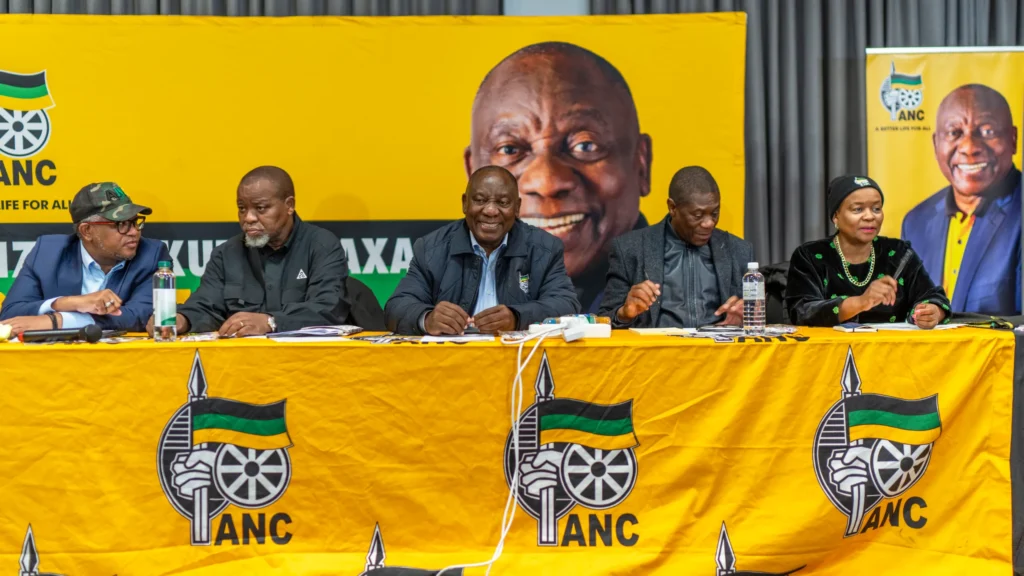South African President Cyril Ramaphosa and other senior officials of the African National Congress (ANC) convened in a pivotal meeting on Thursday to determine whether to formally propose a “unity” government.
This government would encompass all major parties to address a political impasse in the country’s most industrialised nation before the 16 June deadline.
A government of national unity, highlighted as the preferred option by ANC officials, recalled South Africa’s transition from apartheid’s white minority rule to democracy in 1994. During that transformative period, newly elected President Nelson Mandela included political adversaries — even the final apartheid leader — in his first administration to promote unity in a divided nation.
Unlike Mandela’s voluntary act of reconciliation, the ANC’s current push for unity was necessitated by the loss of its 30-year majority in last week’s election, forcing it to collaborate with others to form a government. The ANC, which had comfortably maintained a majority since the end of apartheid, garnered just 40% of the vote in this election, though it remained the largest party.
“We wanted to bring everyone on board,” ANC Secretary-General Fikile Mbalula said regarding the unity government proposal. He mentioned that the ANC meeting, which would decide whether to support this idea over a narrower coalition with one or two parties, was expected to last all day.
An agreement needed to be reached by 16 June, the deadline for South Africa’s new Parliament to assemble and elect a president. South Africans voted for parties, which then received seats in Parliament proportionate to their share of the vote. Lawmakers subsequently elected the president. While Ramaphosa was still anticipated to be the candidate for president in a multi-party government, this needed formalisation. The ANC would need support from other parties to re-elect him, given it had lost its parliamentary majority. Ramaphosa, 71, was seeking a second and final term.
South Africa aimed to minimise any uncertainty through what promised to be a complex process likely to extend well into the following week, keeping South Africans on edge during one of the most critical times in their young democracy.
The unity government appeared a more likely scenario than a direct coalition between the ANC and the main opposition Democratic Alliance (DA) party, which secured the second largest share of the vote with nearly 22%.
More than 50 parties contested the election, with at least eight receiving significant support. They ranged from the centrist DA, seen as a business-friendly party, to the far-left Economic Freedom Fighters (EFF), which advocated for the nationalisation of sectors like South Africa’s key gold and platinum mines and the central bank.
There was also the new MK party of former President Jacob Zuma, which stated it would not negotiate while Ramaphosa was ANC leader, largely driven by Zuma’s animosity towards his successor.
Any unity government proposal from the ANC would still need to be presented to those other parties, some of whom were more opposed to each other than to the ANC. The DA pledged never to collaborate with the EFF or MK, for example, highlighting the significant divisions to overcome.
There was also a split within the ANC, which was not entirely supportive of the unity government possibility. Mbalula anticipated debate and disagreement in Thursday’s meeting, which was likely to last all day. The meeting involved the ANC’s National Executive Committee, a body of over 80 senior party members including Ramaphosa as ANC leader, which decided the party’s direction.
While the ANC’s top leaders were seen as open to a direct coalition with the DA, grassroots party members opposed this, often with racial undertones not far from the surface in a country still grappling with its history of severe segregation.
Some ANC supporters and allies, such as the national congress of trade unions, portrayed the white-led DA as a party prioritising the interests of South Africa’s white minority over Black people, who made up more than 80% of the population.
The DA denied this characterisation and pointed to its substantial numbers of Black supporters, reflected in the fact that it received the second-highest number of votes nationwide.
Political analyst Asanda Ngoasheng remarked that the inclusive national unity government plan was “the safest option” for the ANC to stabilise its base after its worst election result and to avoid the economic uncertainty that might follow a narrower coalition with the Marxist EFF party.
“I believe a government of national unity with multiple parties in collaboration … is the best approach and the prudent decision,” she said on the Newzroom Afrika news channel.
Follow us on:
